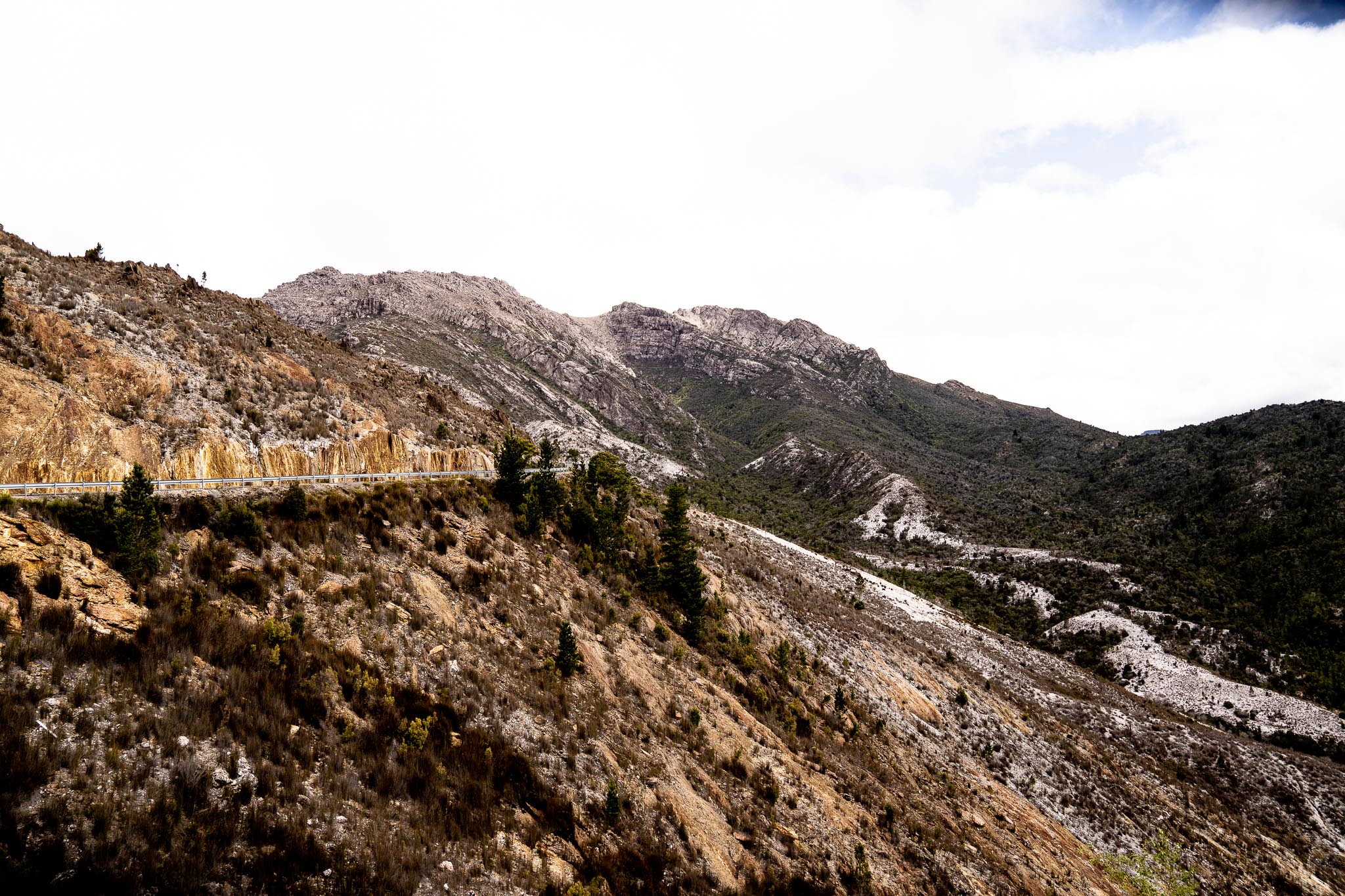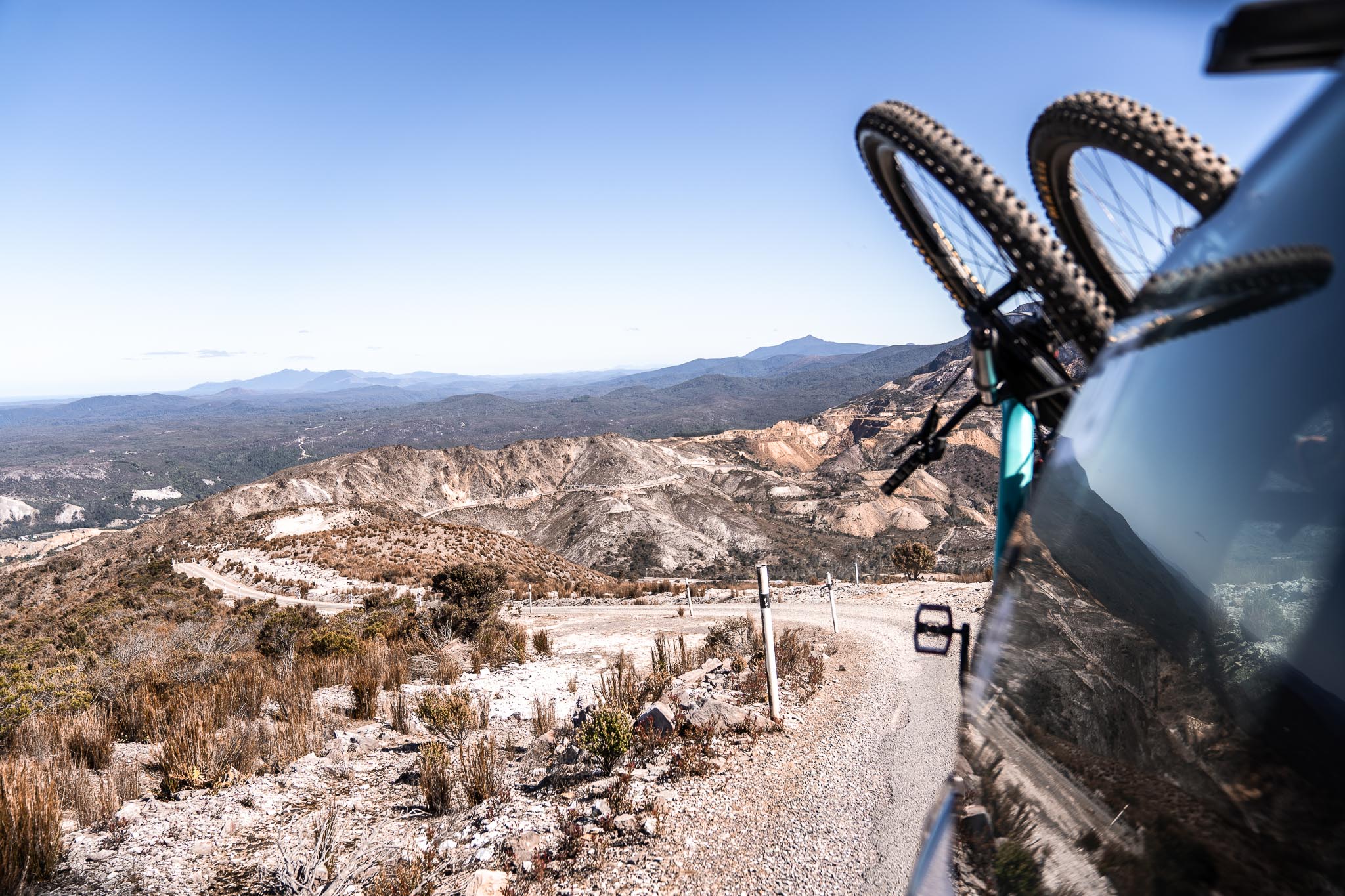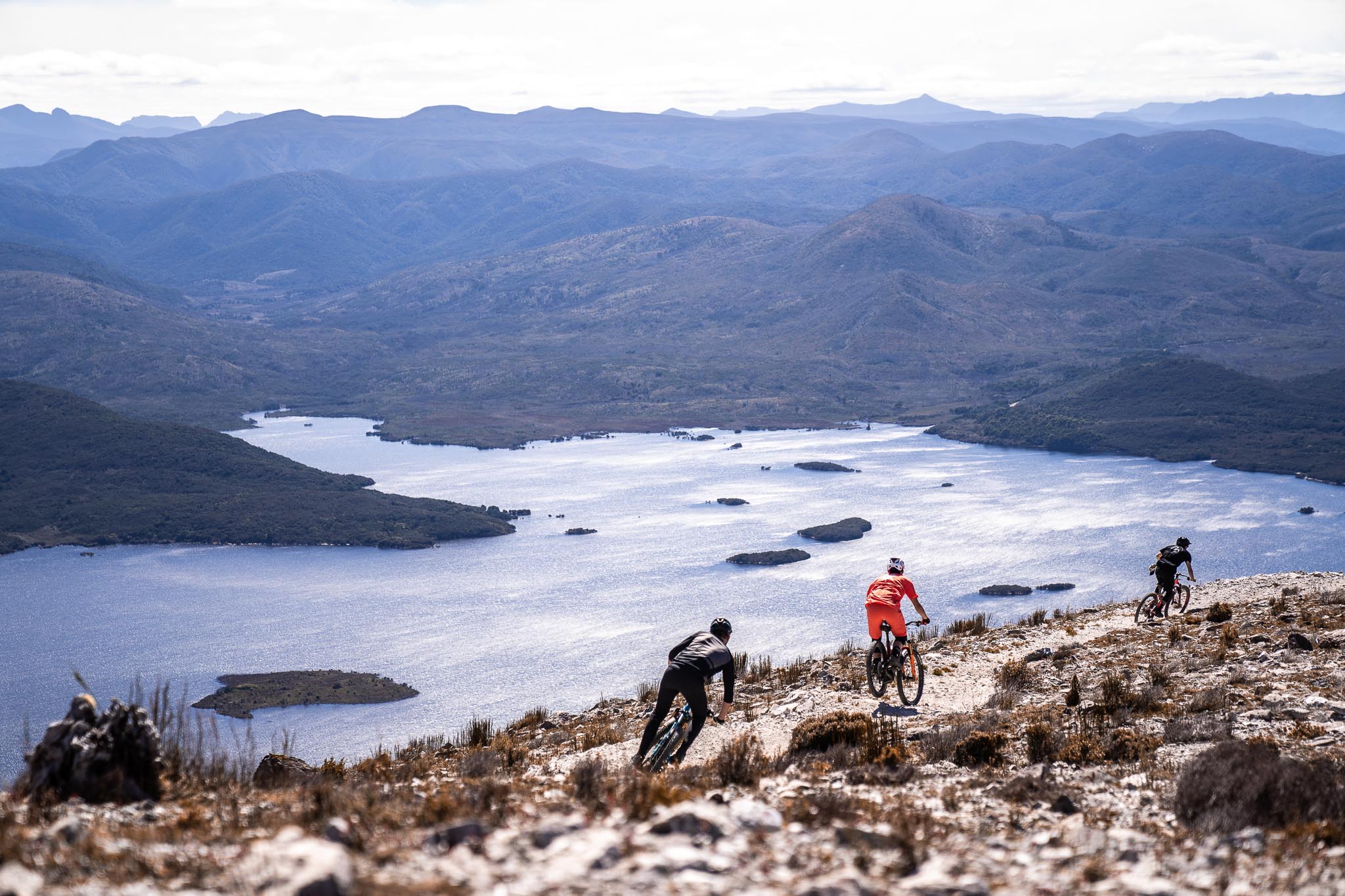Tasmania's West Coast: A Ride on the Wild Side
Underdeveloped, less populated, and with mere pockets of phone reception, the West Coast of Tasmania promises an experience far removed from the typical bike park atmosphere.
Words and photos: Georgina von Marburg
Tasmania has rightfully affirmed its place as one of the best riding destinations in the world. Trail networks such as Blue Derby and Maydena Bike Park have lured world class riders and events to otherwise sleepy towns thanks to their incredible trail networks and exotic landscape. But while the shuttle lines are overflowing at these popular places, a different style of adventure has been brewing over on the west coast of Tasmania. Underdeveloped, less populated, and with mere pockets of phone reception, the West Coast of Tasmania promises an experience far removed from the typical bike park atmosphere. It’s as remote as it is spectacular, and fresh trail networks have made it accessible for riders ready to step outside their comfort zone.
With a crew of five friends, I had planned an early summer holiday in the south and decided to add a few new stops to the typical Tassie tour. This included Queenstown, a three hour drive from Maydena, and Zeehan, a thirty minute drive north of Queenstown.

After traversing through the windy, misty roads from Hobart, we understood why most people choose to reach Queenstown from the north rather than the south. But while the roads are sometimes tedious, the visual reward is definitely worthwhile. The drive takes you through some incredible state forests with stark white trees and reddish hues littering the undulating terrain. There were enough cafes and petrol stations to restock caffeine and fuel along the way, and as the designated driver of the ‘party bus’, I was extremely grateful for this.

As we reached the outskirts of Queenstown, the low-hanging clouds cleared, and my sleepy passengers awoke from their slumber. Suddenly the dense forest opened up to a stark and mountainous terrain unlike anything I’ve seen before. As we would soon learn, the famous barren peaks surrounding Queenstown are actually the consequence of mining methods conducted back in the early 20th century. But man-made results aside, these sharp, rocky faces are a sight to behold.

Queenstown is traditionally a mining town with a population of around 2000; but it has recently transformed into a creative melting pot where artists will stay and work, inspired by the mountains and history. Evidence for this is scattered around the town, with giant murals and paintings on the buildings and walls.

After checking into our cosy cabins at the Mountain View Motel, we strolled down the main street to Queenstown’s newest and coolest watering hole, the Moonscape Wine Bar. On tap were a selection of western Tasmanian craft beers (we promptly taste tested all of them), and an array of local wines accompanied by cheese boards. Not a bad start to a Monday evening. While at Moonscape, we caught up with Aaron from West Coast Council, and Rob Potter, the brains behind the Queenstown trails (and a few others!). With breakfast and shuttles located, we were set for an epic few days.

Day 1 – Queenstown: Summiting Mount Owen

After checking out of Mountain View Motel, we headed to the trailhead. Like everything in Queenstown, the trailhead is quaint and unique: it’s non-other than a converted theatre from the 1930s maintained in its original state. Outside the grand old doors is a fleet of Roam Wild Tasmania’s Toyota Prados; as we’d soon learn, the road to Mount Owen is steep and treacherous, so individual 4x4s with vertical bike racks are the most secure – and stylish – mode of transportation. We piled into the cars and the drivers began a casual tour of the town. As we drove through the historic streets, they pointed out all the significant sights including Queenstown’s in-use gravel football field. They breed them tough here.

The drive to the top of Mount Owen takes approximately 20 minutes, but it didn’t feel long enough as we asked the driver to slow for photos. The barren rocky peaks of Western Tasmania are juxtaposed by the still blue waters of Lake Burbury below, and we took a moment at the summit to pinch ourselves.

Renowned trail builder Rob Potter was present to escort us down the long descents and traverses. Mount Owen contains about 35km worth of trails, split over 5 main descents and two shuttle drop-off points. Assembled by the masters of flow, Dirt Art, all the trails are characterised by sweeping berms and rolling straights. But as we leapt into the first blue run of the day, we realised the flow trails at Mount Owen are not to be underestimated. Put it this way: steep is to Maydena as loose is to Queenstown. The infamous white gravel is akin to a bed of marbles, forcing riders to readjust their idea of traction and get used to drifting on two wheels. At first, the surface was daunting; but the less we fought against the lack of grip, the more fun we had. Adapt and conquer!

Comfortable with a few of the blue trails, we asked Rob to lead us down the black diamond trail, North Owen descent. To access this trail, you must traverse across the Chamouni Traverse from the shuttle drop-off point; this is a short descent and climb to the summit where the North Owen trail begins. The harder trails at Mount Owen don’t include any significant features involving high levels of commitment; they’re just extra steep, and extra loose. We were grabbing the brakes nearly all the way down, trying to relax the arm-pump as we traced skids marks down the fall line. The type of riding around Mount Owen takes several days to get comfortable with, and surely years to master.

But the crowd favourite at Mount Owen was undoubtedly the Waterfall track. This trail had everything: from doubles assembled from boulders to endless tight corners, all funnelling down a gulley overlooking Queenstown. We loved this trail so much we did it twice, despite the 20 minute climb required at the end to exit the network. Our second run was at sunset, which we highly recommend as an experience in itself. Riding westward, we chased the last light into town before collapsing at the exquisite local Thai joint, Rusty Iron.

We spent the second night at the Gold Rush Inn with generously sized motel rooms and a dedicated bike wash station. Reminiscing over our day at Mount Owen, we were all astounded by the truly unique terrain. Dien, a resident mechanic at Fox Factory Australia, was still in awe by what he had witnessed. “The views were nothing I’ve ever seen before, and riding surface is nothing like I’ve ever experienced before. It’s pretty hard to ride because you’re concentrating on the loose turns, and also looking at this incredible view! I would 100% go back, even just to look at the views again.”

Day 2 – Zeehan: The Silver City Trails
Most of us had never heard of the West Coast town of Zeehan before, but it was once a flourishing mining town and one of the largest in the state. It’s an uncanny place to build trails, with little more than a post office and friendly pub. But whisperings of Next Level MTB’s work had dispersed through the mountain biking world, and we dragged Rob Potter out for another excursion.

The Silver City network is brand new, so new that we were the first public tyres on the dirt. We decided upon the long loop, one of three loops in the region ranging from beginner to advanced. This advanced loop begins in town, but we skipped the first 5km as this section of dirt was still too soft to ride. The riding here caters perfectly to 120mm-140mm down-country bikes – or super keen enduro riders with downhill casing tyres such as ourselves.

Securing plenty of snacks inside the camera bag, we perched up on a hill overlooking the Heemskirk Range. From this starting point, we could see exactly where our journey would take us. The bright white trail surface stands out against the low-cut plains, providing a live map for riders along the way. It’s one of the few places in the world you can see exactly where you’ve ridden, and exactly where you need to go. This is all thanks to a notable lack of trees, which Rob explained is the result of indigenous burn-offs and natural bush fires over thousands of years.

Just as there is a distinct lack of trees, there is also a complete lack of fire trail access. This network reaches some truly remote places, requiring the ambitious trail builders to dig their way out and back. If anything went wrong during the process, it would be a mission on a motorbike to bring spare parts and supplies. The trail builders relied on natural streams for water, and we followed suit during our ride. We can confirm no one felt sick after drinking from the fast-flowing water; however, if you’re not game enough, we’d recommend taking a hydration pack on this journey, as well as plenty of spares and a first aid kit.

The surface of the terrain is a dark and sandy soil, too susceptible to corrosion. The builders had to therefore dig further to expose a white and rocky soil similar to that of Queenstown. And like Queenstown, the Zeehan trails are loose. Thankfully we had ridden Mount Owen the day before, so we were well accustomed to two-wheel drifting.

The 30km loop begins on undulating singletrack, traversing over small hills before reaching the most significant climb. This climb is one of the most scenic climbs you will ever ride, making its steep and sometimes technical nature a worthwhile undertaking. One side of the ridge line looks across endless mountains, while the other side looks westward towards the distant ocean. We stopped on multiple occasions, nudging and smiling at each other as we discovered another spectacular view around each switchback.

After reaching the summit, the long and rocky descent down Heemskirk awaited. It’s a predominantly flowy affair with plenty of optional advanced lines and features. The corners are perfectly structured, allowing riders to push hard into the high lines. And while more undulation was to come, the stoke from the tasty descents kept us motivated all the way home. In total, we accumulated 1200m of climbing over 3 hours of moving time, and every minute was worth it.

As Tom Locke aptly surmised, the Silver City trails embrace the essence of mountain biking. “You sat there on your bike all day and remembered why you love bikes. It wasn’t about one descent; it was about spending the day with your mates riding your bike.”

Complementing the wild adventure we had just undertaken, our day concluded in the most appropriate way possible: glamping at the Zeehan Bush Camp. These finely appointed tents had all the comforts of home, including queen beds and power points, while still embracing the great outdoors. Firewood and marshmallows were included, as well as a pristine kitchenette with a coffee machine. After travelling through Tasmania for two weeks, we all agreed this was our favourite accommodation yet!

Our take on riding the West Coast
Here at AMB, we hear a lot of hype about a lot of new trails. Some are worthy investments of time, and some can be underwhelming. I travelled to the West Coast with minimal expectations considering the small number of actual trails compared to other destinations. But this trip resulted in a lesson about quality over quantity; we spent entire days riding and shuttling through truly epic terrain surrounded by scenery many would fly half-way across the world for. The West Coast of Tasmania will lift your soul, while challenging your skills on a bike; its remoteness will leave you refreshed and revitalised, while its trails will leave you a new and improved rider. Despite spending copious time at the major bike parks of this little island, at the end of the trip, it was the West Coast that remained the most memorable. Thank you to the West Coast Council for organising our itinerary, and for all the local businesses that made our trip so special!
Queenstown
Shuttles:
Book single, half-day, or full-day shuttles with the friendly and helpful staff at Roam Wild Tasmania.
Where to stay:
Mountain View Motel – backpacker accommodation catering to singles, couples, or groups. Super friendly to mountain bikers! Fast wifi and the ability to park right outside your door.
Gold Rush Inn – spacious and comfortable en-suites or apartments with a bike wash bay and coin operated laundry. Quiet location, perfect for a good night’s sleep.
Where to eat:
Tracks Café – right on the main street, supplying all your coffee and hot breakfast needs with outdoor seating and bike racks.
Moonscape Wine Bar – the ultimate post-ride park up! A vast array of local beers, wine, and share plates, with outdoor seating and plenty of bike racks.
The Confluence Hotel – a classy pub with an extensive menu and warm atmosphere.
Rusty Iron Thai-Chinese – don’t be fooled by the location – this is authentic Thai and Chinese cuisine at its best!
Zeehan
Where to stay:
Zeehan Bush Camp – hands down the best way to experience the Silver City. Embrace the outdoors with their glamping facilities, while still having all the comforts of home!
Where to eat:
Carol’s On Main – hot coffee and the best homemade sausage rolls in Tassie.
Cecil Hotel – old style pub with the friendliest staff and most generous servings. You won’t be left hungry!







